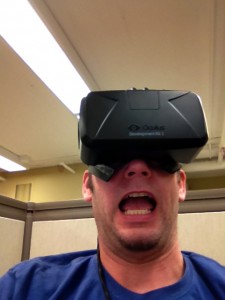During our transnational seminar I went from a Luddite without a smartphone to the technological Vanguard. Minutes ago with the help of my Oculus virtual reality headset, I single-handedly saved the Earth from a meteor shower. You’re welcome. Yet, Randall Halle (2006) is dismissive of rapidly changing transformations in technological reproducibility of images, emphasizing instead changes in the marketability of film: “All due respect for the impact of computer-generated imagery on the visual arts aside, I would insist that…radical transformation in the productive forces come not from technological innovation” (Halle, 1). Benjamin Walter and I respectfully disagree with Randall Halle. Indeed, this seminar has broadened by appreciation for the semiotic power of rapidly changing technologies and the images that they produce and we, in turn, consume.
Halle discusses Walter Benjamin’s thesis “Das Kunstwerk zur Zeit der technischen Reproduzierbarkeit” (Art in the time of technical reproducibility). Benjamin’s thesis on reproducibility of art describes how art loses its creative Aura through technological reproduction, and discusses the evolution of the captured image from photography to film. Benjamin believed that technological reproducibility stripped the artwork of its patina, of its semiotic power, of its “Hier und Jetzt” (Here and Now-ness). Global access to audio-visual content, I believe, has largely anesthesized its viewing audiences, which Benjamin theorized could lead to an aesthetic politicization such as fascism. I believe it is within these new ‘techno’- and cyberscapes that we come head-to-head with many of the theorists addressed in our seminar.
“[T]hen today education is the ultimate utopia” (Augé, X). Our transnational seminar has also opened my eyes to unequal access to educational opportunities. Among the list of audio-visual ‘goodies’ offered at McKeldin Library include: Oculus virtual reality headset, Google glasses, 3-D printer, and 3-D scanner. I have used all of them and have decided that these devices represent a new Frontera to which really only a privileged elite has access. The tuition-paying students and TA’s should count themselves among the fortunate few in a larger community of have’s and have-nots who can access these technologies. “This erasure of frontiers is brought to centre stage by audio-visual technology and the management of space. The spaces of circulation, consumption and communication are problem areas, ghettos, poverty and underdevelopment…” (Augé, XIII). It cost $17.92 to print the three items on McKeldin’s 3-D printer:
Object 2: My 3-D printed basket, large enough to fit a grilled cheese sandwich.
Object 3: Berlin’s Ampelmann (a bottle-opener)
This course has also fostered my sense of play. I enjoyed the experimental nature of this course and have overcome the corresponding fear of failure. I am excited about my ventures into the new technologies offered at McKeldin and am really optimistic about their accessibility to the student body and the potential to enhance students’ educational experiences. I think Appadurai’s emphasis on the role of the imagination is appropriate in relation to these gadgets.
Nevertheless, a chasm exists between UMD and the various communities in which it is nestled, both technologically and socially. A survey of campus culture shows how “[w]alls, partitions, barriers are appearing on the local scale and in the most everyday management of space” (Augé, XIII). This transnational course has made me think long and hard about the purpose of and access to education, as well as the neoliberal trajectory that all educational institutions are taking. Only those who can contend with the rising costs of higher education and excessive UMD fees (late tuition finance charges, parking tickets, etc.) can occupy the privileged educational space at our public university.
This seminar has also showed me that the University of Maryland is as much of a non-space as an airport. As undergraduate and graduate students we wait in anticipation of attaining our credentials in order to take flight into the wider world. All the while we often breeze past janitors or conduct hasty transactions with the fast food workers in the Stamp. Anzaldua’s Frontera is readily apparent on our campus. It often seems like our student and faculty body form a community vantage point – albeit a global and diverse one – from which many people in UMD’s immediate environment are excluded. What if Bhabha’s Beyond were staring at you from the other side of Panda Express?

